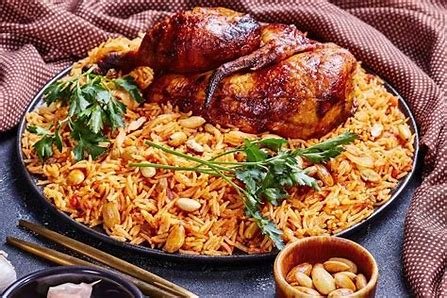Information about Oman Famous Food
Omani cuisine is proof of the country’s rich cultural heritage that blends influences from maritime trade history and traditional Bedouin lifestyle. The country’s varied landscape, stretching from coastal regions to mountainous terrains, has created a unique culinary identity. Food lovers can start a journey through unforgettable gastronomic experiences here.

Shuwa
stands out as Oman’s most celebrated dish and captures the essence of traditional Omani food culture. This slow-cooked meat delicacy requires lamb or goat marinated with traditional spices, wrapped in banana leaves, and cooked in an underground sand oven for up to 48 hours. The meat becomes incredibly tender and falls off the bone while getting infused with aromatic spices like cumin, coriander, and black pepper.
Mishkak brings Oman’s street food culture alive. Local markets and street corners commonly feature these grilled meat skewers seasoned with special Omani spices. The meat, typically chicken or beef, gets its distinct smoky Omani flavor from a marinade of yogurt, lime juice, and local spices before being grilled over charcoal.
Let’s take a closer look at three life-blood dishes of Omani cuisine that highlight the country’s culinary expertise:
- Majboos – A fragrant rice dish cooked with spiced meat, featuring saffron, cardamom, and rose water
- Harees – A hearty wheat and meat porridge, traditionally served during Ramadan
- Qabuli – A sophisticated rice preparation with meat, raisins, and nuts, reflecting Oman’s trading heritage
Mashuai represents Oman’s coastal heritage in its famous food scene. The dish features whole grilled kingfish stuffed with a tangy mixture of lime, tomatoes, and traditional spices. It captures the Arabian Sea’s flavors perfectly when served on a bed of lemon rice or with khubz (traditional Omani bread).
Maqbous, the vegetarian star of Omani cuisine, combines rice with aromatic spices and vegetables. Saffron and turmeric give the dish its distinctive yellow color, while cardamom pods and cinnamon sticks create complex flavor layers. A side of spicy tomato sauce and fresh yogurt complements this dish perfectly.
Arsiya brings out the comfort food qualities in Omani cuisine. The dish blends shredded chicken with khubz soaked in a rich broth that creates a porridge-like texture. People often add ghee on top and serve it in cold weather or to sick family members. This practice shows Omani food’s nurturing spirit.

Lokhemat stands out as Oman’s breakfast favorite. These sweet dumplings come with a crispy exterior and soft center, topped with date syrup or honey. Cardamom and saffron flavors make the dough an ideal morning treat or afternoon snack.
Muqalab reflects the nose-to-tail cooking traditions in Omani food. The dish features tripe and organ meats that become tender after slow cooking with various spices. Many people might find it unusual, but Omanis call it a delicacy that shows their resourceful cooking approach.
Khubz Ragag serves as the foundation of Omani bread making. Cooks prepare this paper-thin bread on a special dome-shaped griddle. People enjoy it plain or paired with honey and cheese. Its versatility makes it a household staple, perfect to scoop curries or wrap around grilled meats.

Halwa, Oman’s national dessert, rounds off this food selection. This gelatinous sweet takes hours to make with sugar, eggs, milk, nuts, and aromatic spices like saffron and cardamom. The result becomes a refined dessert that graces special occasions and honored guests’ visits, served alongside Omani coffee.
These dishes tell stories of Oman’s heritage, from Bedouin traditions to coastal influences. The spice choices, slow cooking methods, and shared dining reflect Omani culture’s warmth and hospitality. This famous food does more than satisfy hunger – it opens a window into Omani cuisine’s heart, making it a must-try for anyone learning Arabia’s flavors.
FAQs
What are some traditional Omani dishes that are a must-try? Oman offers a variety of traditional dishes that are essential for any food lover. Machboos, a classic Gulf dish, and Harees Dijaj, a national food of Oman, are highly recommended. During special occasions like Eid, Shuwa is a popular choice. Other notable dishes include Qabooli, Omani bread, and the sweet treat Halwa.
Which dish is considered the national dish of Oman? Shuwa is regarded as the national dish of Oman. This elaborate meal is typically served during significant events such as the Muslim holiday Eid. It is presented on large platters to promote sharing among guests.
What do Omanis typically eat for breakfast? For a traditional Omani breakfast, you might enjoy Khubz Rahal, Khabeesa, and Mardhoof. Accompanying these dishes, Qahwa Coffee and Dates, along with Sweet Karak Tea, are popular choices. Other breakfast items include Al Bagla and Balaleet.
What is a favorite local beverage in Oman? In Oman, popular local beverages include laban, a heavy salty buttermilk, and yogurt flavored with cardamom and ground pistachios. Indian lassi yogurt drinks in various flavors are also widely enjoyed.
Where can I find authentic Omani Shuwa in Muscat? For an authentic taste of Omani Shuwa, consider visiting local restaurants such as Al Mandoos near Al Mouj or Orient in Azaiba. These spots are known for their traditional preparation of this special dish.
What are some recommended snacks and desserts to try in Oman? When visiting Oman, trying Karak chai paired with Ragag, a type of crispy bread, is a must for tea enthusiasts. For dessert lovers, Kunafa, a delightful Middle Eastern cheese dessert available in flavors like Nutella, Cheese, and Caramel, is highly recommended.
















